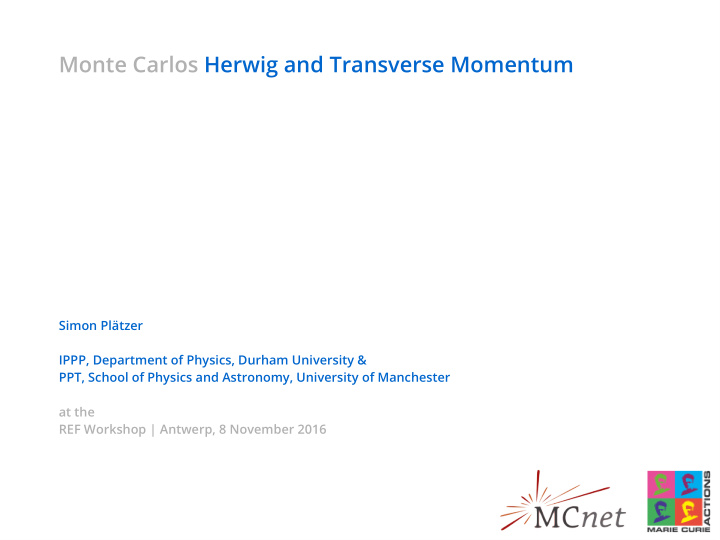



Monte Carlos Herwig and Transverse Momentum Simon Plätzer IPPP, Department of Physics, Durham University & PPT, School of Physics and Astronomy, University of Manchester at the REF Workshop | Antwerp, 8 November 2016
The Herwig Event Generator HERWIG Herwig++ Herwig Herwig++ has seen a ten-year development to meet a milestone intended to succeed the FORTRAN HERWIG program. This milestone evolved over time as the experimental and phenomenological needs did. On top of its fjrst defjnition (= at least as good as HERWIG), precision has become the key goal: NLO matched by default. Herwig++ 3.0 Herwig 7.0 →
Herwig 7 – Core Features [Bellm, Gieseke, Grellscheid, Plätzer, M. Rauch, Reuschle, Richardson, Schichtel, Seymour, Siodmok, Wilcock, Fischer, Harrendorf, Nail, Papaefstathiou, D. Rauch – EPJ C 76 (2016) 196] NLO matched to parton showers as default for the hard process. → Fully automated, only linking external codes to calculate amplitudes. → Run in a single program, no event fjles to move around. → Subtractive (MC@NLO-type) and multiplicative (POWHEG-type) matching. Two showers: Angular-ordered and dipole shower. Spin correlations and QED radiation in angular ordered shower. Facilities for parton shower uncertainties. Improved kinematics reconstruction. Vastly improved documentation , usage and installation. New tunes taking NLO matching into account + much, much more ...
Shower Algorithms Two shower algorithms available: [Gieseke, Stephens, Webber – JHEP 0312 (2003) 045] “QTilde” “Traditional” angular ordered shower: default shower → QED, spin correlations, shower variations, decays → Truncated showering for Powheg-type matching → “Dipole” [Plätzer, Gieseke – JHEP 1101 (2011) 024] Dipole-type evolution, ordered in dipole pt → Extensive shower variations, decays soon (7.1) → Working horse for NLO multijet merging →
Outline Backward Evolution Kinematics How (Not) To Uncertainties Summary
Backward Evolution Backward evolution with emissions at fjnite transverse momentum. Phase space bounds link longitudinal & transverse, recoil not unique.
Kinematics How Not To Problem in initial dipole-type approaches: Z recoil from fjrst emission only. Spectrum vanishes at zero pt from shower only. Initial state spectator not changed, beams always aligned. Typical to dipole subtraction terms, so eases matched calculation. → Similar issue in fjnal state? Would be visible in EEC, however dipoles provide excellent description. →
Kinematics How To Make multiple emissions contribute to fjnal state pt. Common to angular ordered shower from the beginning, equivalent strategy developed for the dipole shower. [Plätzer, Gieseke – JHEP 1101 (2011) 024]
Signifjcant efgect? [Plätzer, Gieseke – JHEP 1101 (2011) 024] similar approach in Sherpa, e.g. [Hoeche, Schönherr, Krauss – Phys.Rev. D90 014012] Look at pT spectra for Drell-Yan or Higgs: “Algorithmic” uncertainty drowned in “perturbative” uncertainty?
Logarithmic structure Uncertainties → [Bellm, Nail, Plätzer, Schichtel, Siodmok – arXiv:1605.01338] Look at generic Sudakov exponent: AlphaS running on top, also PDF arguments.
Uncertainties [Bellm, Nail, Plätzer, Schichtel, Siodmok – arXiv:1605.01338] Aim at evaluating event generator uncertainties in a global prescription Need to evaluate uncertainties of building blocks one at a time. → Then pin down cross feed, making minimal assumptions. → Start with the perturbative part: Parton showers – at leading order! Then check if matching algorithms exhibit the expected improvement. Shower scale variations not a priori clear to serve as estimating an order one term in the next (logarithmic) order – logarithmic accuracy mostly unclear. Rather constrain by demanding controllable uncertainties: Small/large where showers are expected to be reliable/unreliable. → Consistent between two systematically difgerent algorithms. → Not to mess around with hard process input. →
Uncertainty Benchmarks with Herwig 7 [Bellm, Nail, Plätzer, Schichtel, Siodmok – arXiv:1605.01338] Resummation needs to be cut ofg at a typical hard scale veto on hard emissions, region → to be fjlled by matching. Resummation properties are heavily infmuenced by the way resummation is being switched ofg. Study scale variations in angular ordered and Dipole showers at a benchmark setting where we observe absolutely comparable resummation properties: Hard veto scales, factorization/renormalization scales in the shower and hard process.
Uncertainty Benchmarks with Herwig 7 [Bellm, Nail, Plätzer, Schichtel, Siodmok – arXiv:1605.01338] Choice of the hard veto scale is crucial to reproduce hard process input: typically average transverse momenta of hard objects. Controllable uncertainties can only be established by narrow, smeared versions of a theta function, confjrming simple LL arguments. We can now check the impact of higher order improvements.
Summary Contemporary shower algorithms generate transverse momenta from many initial state emissions. Difgerent prescriptions possible, need to be confronted with other sources of uncertainty. Available shower phase space and “smearing” of pT dependence to cutofg resummation are crucial to variation pattern.
Thank you!
Recommend
More recommend